
Overview
Welcome to the first Apartment List National Rent Report of 2023. Our national index fell by 0.8 percent over the course of December, marking the fourth straight month-over-month decline. The timing of this cooldown in the rental market is consistent with the typical seasonal trend, but its magnitude has been notably sharper than what we’ve seen in the past. This suggests that the recent swing to falling rents is reflective of a broader shift in market conditions beyond seasonality alone. As we look ahead to the new year, we expect that 2023 will see bargaining power shift back to renters, and that rent prices this year will grow only modestly, if at all.
Over the course of 2022 as a whole, the national median rent increased by a total of 3.8 percent. This means that last year represented a return to pre-pandemic levels of rent growth, after the astronomical 17.6 percent spike in rents that we saw in 2021. Rent growth in 2022 still ranks as the second fastest year in the history of our estimates (going back to 2017), but it came in just barely ahead of the 3.5 percent rate from 2018.
The cooldown in rent growth is being mirrored by continued easing on the supply side of the market. Our vacancy index now stands at 5.9 percent, after more than a year of gradual increases from a low of 4.1 percent last fall. And in the past four months, this easing of the vacancy rate has picked up steam again, after plateauing a bit over the course of last summer. Today’s vacancy rate still remains slightly below the pre-pandemic norm, but is quickly approaching that benchmark.
The recent slowdown has been geographically widespread. Rents decreased in December in 90 of the nation’s 100 largest cities. New York City saw the nation’s sharpest decline, with prices down by 3 percent month-over-month. And over a longer horizon, we are continuing to see an ongoing cooldown in many of the recently booming Sun Belt markets. Las Vegas, Phoenix, Jacksonville, and Riverside all rank in the top 10 for fastest rent growth since March 2020, but none of these metros has seen rents increase by more than 1 percent over the past twelve months.
Rents nationally fall by 0.8% month-over-month; prices still up 4% year-over-year
The national median rent increased by a record-setting 17.6 percent over the course of 2021. This rapid growth in rent prices is a key contributor to overall inflation, which is currently rising at its fastest pace in four decades.1 With inflation top-of-mind for policymakers and everyday Americans alike, our rent index is particularly relevant, since movements in market rents lead movements in average rents paid. As a result, our index can signal what is likely ahead for the housing component of the official inflation estimates produced by the Bureau of Labor Statistics. Thankfully for the country’s renters, our national rent index has shown rent growth decelerating quickly in recent months. In fact, for the past four months, our index has actually been declining.

We estimate that the national median rent fell by 0.8 percent month-over-month in December. This is the fourth consecutive monthly decline, and the third largest monthly decline in the history of our estimates, which start in January 2017. The preceding two months (October and November 2022) are the only two months with sharper declines.
Rent declines at this time of the year are typical, as rental activity tends to slow down in the fall and winter months. That said, this year’s dip has been significantly sharper than what we typically see. Prices have now fallen by a total of 3 percent since August, which is the sharpest four-month decline in the history of our index. For comparison, from August through December of 2021, prices increased by 2.4 percent, as the market continued on an unprecedented stretch of record-setting rent growth which disrupted seasonal trends.
The recent dip suggests that we may be entering a new phase of the rental market rollercoaster, with changing economic conditions now relaxing rental demand just as supply constraints are easing. That said, the fact that December’s decline was a bit more modest than November’s suggests that we shouldn’t expect rents to continue falling indefinitely. The current seasonal downtown may last a bit longer than usual, but it’s likely that we’ll see a return to positive rent growth once moving activity picks back up in the spring and summer months.
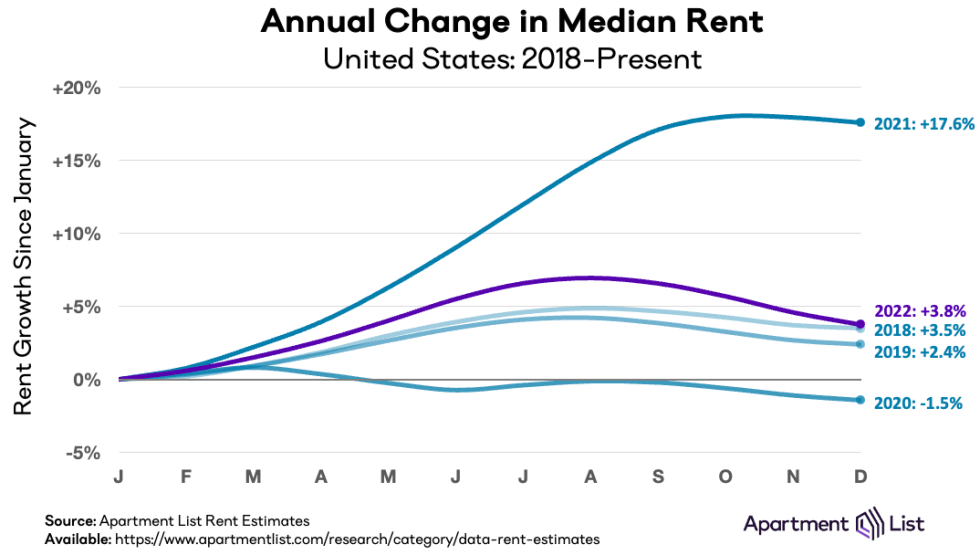
Over the course of 2022 as a whole, rent growth came in at 3.8 percent. This makes 2022 the second fastest year of rent growth in our index’s history (going back to 2017). That said, last year’s growth was nowhere close to the astronomical 17.6 percent increase in prices that we saw in 2021. And although last year’s rent growth was pacing well ahead of pre-pandemic trends in the first half of 2022, the gap narrowed significantly in recent months as prices declined. In the end, full year rent growth for 2022 landed just slightly ahead of the 3.5 percent rate that we saw in 2018.
As rent growth slows, vacancies ease
As we’ve explored in detail, much of the 2021 rent boom was attributable to a tight market in which more households were competing for fewer vacant units. Our vacancy index spiked above 7 percent in the early months of the pandemic in 2020, as many Americans consolidated households and moved in with family amid the uncertainty and economic disruption of the pandemic’s onset. After that, however, rapid household formation drove a sharp tightening of the vacancy rate, which eventually fell to a low of 4.1 percent last fall.

But after bottoming out at 4.1 percent in October 2021, our national vacancy index has been on a trend of gradual easing for over a year. And the pace at which the vacancy rate is easing has been picking up a bit of steam in recent months, as rent growth has turned negative. In the four months from April through August, our vacancy index ticked up by a total of just 0.2 percentage points, from 4.9 percent to 5.1 percent. But in the most recent four months from August through November, it has increased by 0.8 percentage points, reaching 5.9 percent this month.
After a prolonged period of skyrocketing rent growth, and with non-housing related costs also getting more expensive as a result of broad-based inflation, it seems that some Americans are moving back in with family or roommates, or delaying striking out on their own. At the same time, new apartment construction is picking up steam again after facing pandemic-related delays in recent years. In fact, there are currently more multifamily units under construction than at any point since 1970. This combination of slowing household formation and rising inventory is driving the recent shifts that we are seeing in both our rent growth and vacancy indexes.
Vacancy trends are highly localized, and they have been a key indicator of rapidly evolving conditions in local markets across the U.S. throughout the pandemic. To explore the topic in greater detail, monthly vacancy data are now available for download for hundreds of cities, metros, and states, and can be easily linked to our existing rent estimates using Federal Information Processing System (FIPS) codes.
Rents fall month-over-month in 90 of 100 largest cities
The chart below visualizes monthly rent changes in each of the nation’s 100 largest cities from January 2019 to present. The color in each cell represents the extent to which prices went up (red) or down (blue) in a given city in a given month. In 2020, we can see that rents fell sharply in many of the nation’s largest and most expensive cities, while smaller and more affordable ones picked up steam, leading to some convergence in prices. Meanwhile, the dark red band in 2021 depicts last year’s rent heatwave, which peaked in July and August 2021 when all 100 cities in this chart saw prices go up. The rightmost columns show that the recent cooldown has also been geographically widespread.
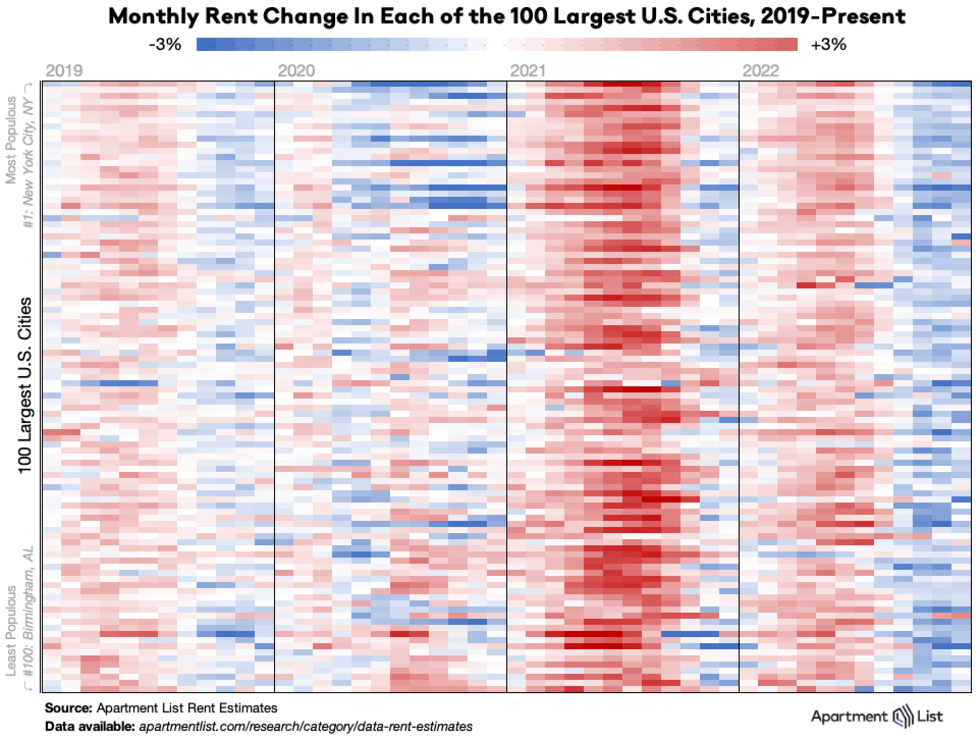
Rents decreased this month in 90 of the nation’s 100 largest cities, while only seven cities saw prices increase. And in 99 of the top 100 cities, rent growth in 2022 was slower than it was in 2021. The largest city-level decline this month was in New York City, where rents fell sharply by 3 percent from November to December. Portland (-2.9%), Seattle (-2.8%), and San Francisco (-1.7%) also all saw prices decline this month at more than double the national rate.
Midwest markets picking up steam
Major markets throughout the Sun Belt have experienced truly disruptive levels of rent growth since the start of the pandemic, but over the past year, the fastest growth has actually been occurring in the Midwest. The following table shows the ten metropolitan areas that have experienced the fastest rent growth over the past six months, over the past year, and since the pandemic started in March 2020:
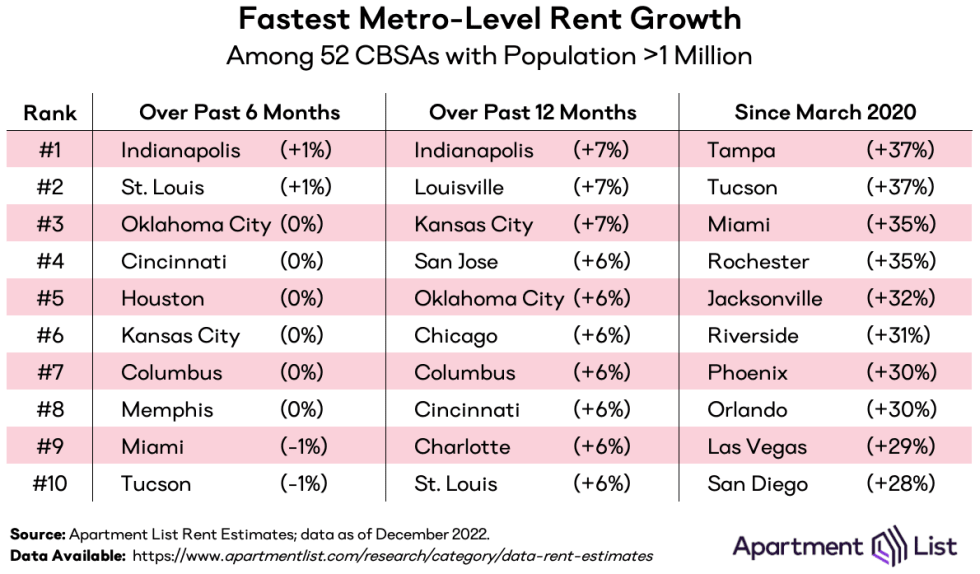
Indianapolis has seen the nation’s fastest metro-level rent growth over the past 12 months, with prices there up by 7.4 percent year-over-year. In addition to Indianapolis, five other Midwestern metros – Kansas City, Chicago, Columbus, Cincinnati, and St. Louis – rank among the top 10 for fastest annual rent growth. With many previously affordable Sun Belt markets having seen rents spike by 30 percent or more over the past two and a half years, markets in the Midwest may now represent some of the last bastions of affordability, and could therefore be drawing new attention.
That said, given the recent nationwide cooldown in rent growth, even the metros currently topping this list are experiencing relatively modest growth compared to what we were seeing in 2021 and the first half of last year. As recently as last July, all but one of the 52 metros with a population over one million logged year-over-year growth rates greater than Indianapolis’s current 7.4 percent rate which is now the nation’s fastest. And over the past six months, no large metro has seen prices rise by more than one percent.
Some booming Sun Belt markets have plateaued
The San Francisco metro experienced the sharpest rent decline in the first year of the pandemic, and has been the slowest market to recover in the time since then. It now looks as if this sluggishness could be set to continue with a seasonal slowdown. Metro-wide, Bay Area rents fell by 1.2 percent in December and are down by 4.5 percent since August, both figures representing a sharper cooldown than the national average. The neighboring San Jose metro experienced an even sharper 1.8 percent dip this month, which brought that metro’s median rent back below its March 2020 level.
San Francisco and San Jose are the only two large metros where the median rent is currently cheaper than it was at the pandemic’s onset. And at the city-level, some markets in the San Francisco Bay Area are recovering even more slowly, particularly in the more densely populated core cities. In Oakland, rents are still down 14.1 percent compared to March 2020 – the biggest discount among the 100 largest cities – while in San Francisco proper, rents are still down 12.6 percent.
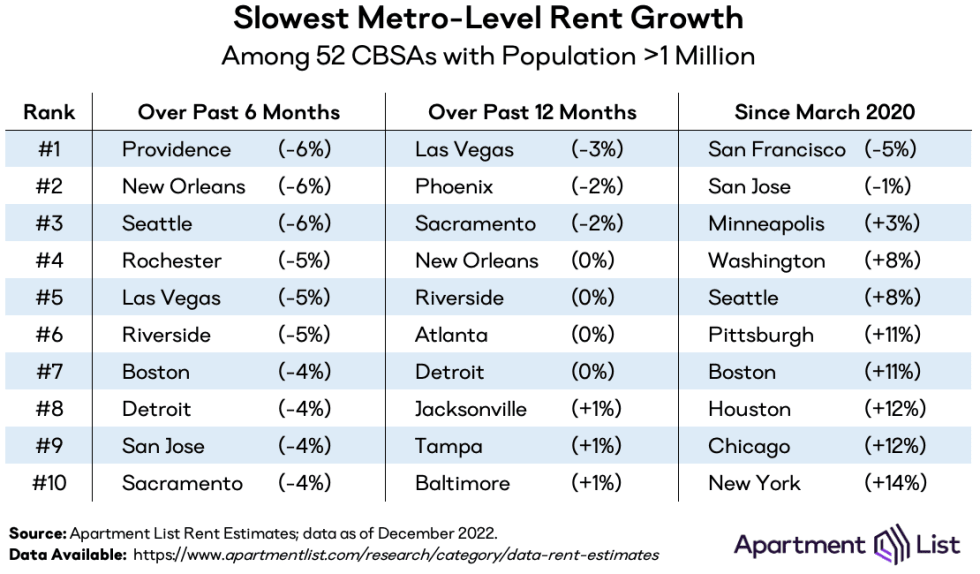
After San Francisco the right-most column of the table is largely populated by other pricey coastal metros, including San Jose; Washington, D.C.; Seattle; Boston; and New York. Even as many of these markets have rebounded over the past year and a half, they have still had among the most modest rent growth over the course of the pandemic as a whole. That said, just five metros have experienced rent growth of less than 10 percent over the past two and a half years.
Notably, the table above also shows how some of the markets that had been booming fastest are now showing signs of cooling off. For example, over the past year, prices are slightly down in Las Vegas (-3 percent) and Phoenix (-2 percent), despite the fact that both metros rank among the top ten for fastest pandemic-era rent growth. Riverside, Jacksonville, and Tampa similarly rank in the top 10 for both fastest growth since March 2020 and slowest growth over the past year.
Conclusion
With December’s 0.8 percent decline, rent prices have now dipped nationally for four straight months. We closed out 2022 with full year rent growth just shy of 4 percent, a rate that is slightly above pre-pandemic levels. The recent cooldown seems to suggest a shift in market conditions that goes beyond seasonality alone, as demand cools and supply constraints continue to abate. This seasonal dip is likely to persist through the winter, but as moving activity picks back up in the spring and summer, we are likely to see a return to positive rent growth. We expect that 2023 will be a year of flat to modest rent growth, but it is unlikely that prices will fall significantly throughout the year.
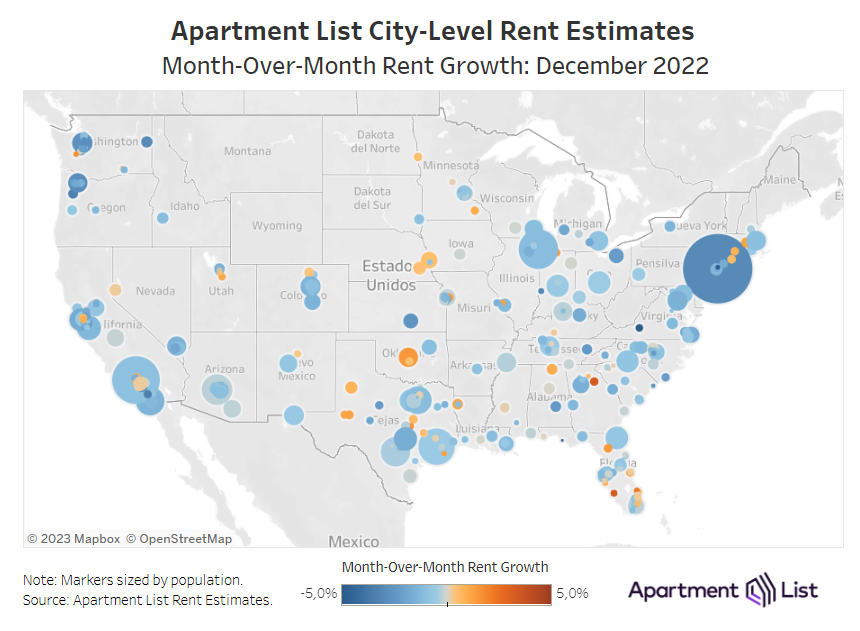
To learn more about the data behind this article and what Apartment List has to offer, visit https://www.apartmentlist.com/.







Sign up to receive our stories in your inbox.
Data is changing the speed of business. Investors, Corporations, and Governments are buying new, differentiated data to gain visibility make better decisions. Don't fall behind. Let us help.













Sign up to receive our stories in your inbox.
Data is changing the speed of business. Investors, Corporations, and Governments are buying new, differentiated data to gain visibility make better decisions. Don't fall behind. Let us help.





